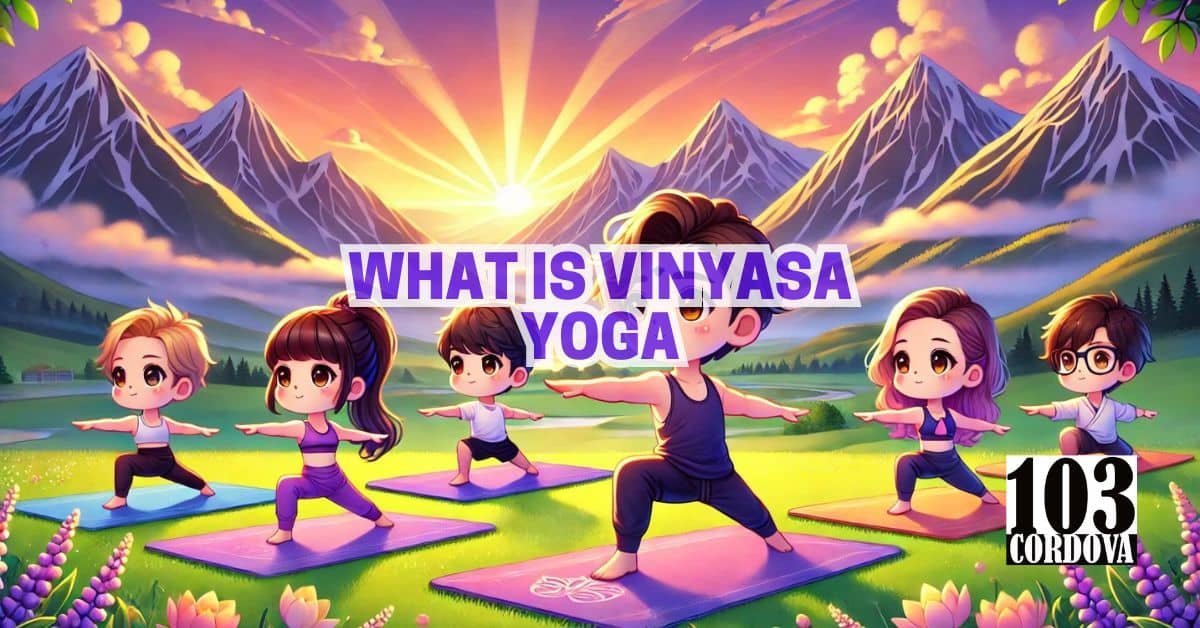Vinyasa Yoga is a style of yoga known for its flowing sequence of poses, synchronized with breath.
Unlike static yoga forms, Vinyasa connects each posture to the next with smooth transitions, making the practice feel more like a dance.
It offers a unique blend of physical and mental benefits that attract people from various fitness levels and goals.
Whether you seek to build strength, increase flexibility, or relieve stress, Vinyasa offers a balanced approach to yoga.
We’ll break down its defining features, history, benefits, and practical tips for starting a Vinyasa practice.
1. What Is Vinyasa Yoga? A Definition
Vinyasa Yoga focuses on the synchronization of breath and movement, creating a continuous flow from one pose to the next.
This connection makes the practice feel more dynamic, as opposed to holding each posture for extended periods.
Each class can be unique, with sequences changing to match the instructor’s style or the class’s focus.
This flexibility means Vinyasa is adaptable for various levels and objectives, making it a versatile form of yoga.
Overall, Vinyasa is about movement, rhythm, and mindfulness, integrating body and breath to build a balanced practice.
🧘 What is Yin Yoga? Understanding Its Principles and Benefits
2. The Historical Roots of Vinyasa Yoga
Vinyasa Yoga originates from the broader tradition of Hatha Yoga, which focuses on physical postures.
Its development is heavily influenced by the teachings of T. Krishnamacharya, considered the father of modern yoga.
Krishnamacharya’s students, like K. Pattabhi Jois helped popularize this dynamic, breath-led approach through Ashtanga Yoga, which shares Vinyasa’s flowing nature.
While rooted in tradition, Vinyasa evolved to become more flexible and less rigid than Ashtanga.
Over time, it has become one of the most practiced yoga styles worldwide, appreciated for its adaptability and creative sequences.
🧘 What Is Hot Yoga? Key Differences Between Hot Yoga and Traditional Yoga
3. Understanding the Concept of Flow in Vinyasa
The “flow” in Vinyasa refers to the seamless, continuous transitions between postures, each guided by an inhale or exhale.
Vinyasa promotes a steady rhythm of movement, in contrast to static styles that hold poses for several breaths.
This flow helps practitioners stay present and focused, as they must align their movements with their breath.
The fluidity of Vinyasa can vary in pace, from slow and mindful to fast and vigorous, depending on the class or teacher.
This concept of flow makes Vinyasa feel energizing and meditative at the same time.
🧘 What Is Hatha Yoga? Understanding Its Role in Modern Wellness
4. The Importance of Breath in Vinyasa Practice
In Vinyasa Yoga, breath serves as the foundation for the entire practice, guiding the flow of movements.
Each inhale or exhale is paired with specific actions, like lifting the arms during an inhale or folding forward on an exhale.
This breath-movement connection creates a rhythmic pace, helping practitioners stay focused and mindful.
Controlled breathing, often referred to as “Ujjayi breath,” also boosts stamina, calming the nervous system while enhancing physical endurance.
Ultimately, breath in Vinyasa isn’t just a support system; it’s a central part of the experience, harmonizing body and mind.
🧘 Is Yoga Good for Arthritis? Exploring the Benefits for Joint Health
5. Exploring the Variety in Vinyasa Classes
Vinyasa Yoga offers a wide variety of classes, each tailored to different goals, energy levels, and experiences.
Some sessions are slow-paced, focusing on gentle stretches and mindful movement, while others are fast and challenging, emphasizing strength and cardio.
Certain classes may center around themes, such as hip opening, core strengthening, or balance work, adding further variety.
This flexibility allows teachers to design unique flows, ensuring that no two classes are exactly the same.
As a result, practitioners can choose a style that fits their needs on any given day, whether they seek relaxation or an intense workout.
🧘 Exploring the Benefits of Pranayama Yoga: Breath Your Way to Better Health
6. Popular Sequences in Vinyasa Yoga
One of the most well-known sequences in Vinyasa Yoga is the Sun Salutation, often used as a warm-up or foundational flow.
It involves a series of postures, such as forward folds, lunges, and backbends, all linked by breath.
Other popular sequences include standing poses, like the Warrior series, or balancing postures, such as tree pose, which can be woven into the class at various points.
Teachers may also integrate seated stretches and twists to promote flexibility and relaxation toward the end of practice.
These sequences help structure the flow while allowing room for creativity and variation in each class.
🧘 Exploring the Physical Benefits of Yoga: Transform Your Body and Mind
7. Physical Benefits of Practicing Vinyasa Yoga
Practicing Vinyasa Yoga regularly offers significant physical benefits, such as improved strength, flexibility, and stamina.
The continuous movement engages multiple muscle groups, providing a full-body workout that tones muscles and enhances overall fitness.
Vinyasa can also improve cardiovascular health due to its dynamic flow, which raises the heart rate.
Additionally, the emphasis on balance and alignment helps increase body awareness, reducing the risk of injury and improving posture.
With time, practitioners experience greater mobility, coordination, and physical resilience, making Vinyasa a comprehensive practice for fitness and well-being.
🧘 Is Yoga Strength Training? The Role of Core Strength and Stability
8. Mental and Emotional Advantages of Vinyasa Yoga
In addition to physical benefits, Vinyasa Yoga significantly enhances mental and emotional well-being.
The practice’s focus on synchronized breathing and movement encourages mindfulness, helping practitioners stay present and reduce stress.
Regular Vinyasa sessions can also lead to improved focus, mental clarity, and emotional balance.
Often, the body releases emotional tension as it moves through various postures, fostering a sense of calm and relaxation.
In time, Vinyasa Yoga can become a tool for managing anxiety, fostering a deeper connection between body and mind.
🧘 Is Yoga Good for You? How It Can Transform Your Well-Being at Any Age
9. Vinyasa Yoga: Suitable for All Levels
Vinyasa Yoga is accessible to people of all fitness levels, from complete beginners to advanced practitioners.
Instructors typically offer modifications for each posture, allowing individuals to adjust the practice based on their abilities.
Beginners can start with simple poses and gradually work toward more complex sequences as they build strength and flexibility.
More experienced yogis can explore advanced variations, making the practice more challenging.
This adaptability makes Vinyasa a welcoming and inclusive form of yoga, ensuring everyone can benefit, regardless of their experience or physical condition.
🧘 Should Christians Do Yoga? Understanding the Intersection of Faith and Fitness
10. How to Get Started with Vinyasa Yoga
Finding a class or following an online instructor is all it takes to start practicing Vinyasa Yoga.
Begin with beginner-friendly sessions that introduce basic postures and guide you through connecting breath with movement.
It’s essential to focus on learning foundational poses like Downward Dog and Sun Salutations, which form the backbone of many Vinyasa sequences.
As you gain confidence, you can explore more challenging classes, experimenting with new flows and poses.
Consistency is key, so practicing regularly will help you build strength, flexibility, and familiarity with the rhythm of Vinyasa.
🧘 Unlocking the Health Benefits of Yoga: How Regular Practice Can Transform Your Well-Being
💡 Conclusion
Vinyasa Yoga stands out for its unique combination of breath, movement, and flow, creating a practice that is both dynamic and meditative.
The rhythmic nature of Vinyasa allows practitioners to experience a deep connection between body and mind, enhancing physical, mental, and emotional well-being.
Its adaptable nature means that anyone, regardless of experience level, can benefit from the practice.
Whether you’re looking to improve your fitness or find mental clarity, Vinyasa provides a versatile and rewarding yoga experience.
Embracing the flow and rhythm of Vinyasa can lead to lasting improvements in overall health and wellness.
🧘 Our Services
Join our Yoga classes for all ages at 103 Cordova Tower, Marquinton Residences, Cirma Street, Sto. Nino, Marikina City.
Whether you’re a beginner or an experienced practitioner, we offer sessions tailored to your needs in a welcoming environment.
Reach out to us at 09176225780 or contact us via Facebook or through our website’s contact form to book your spot.
Our classes aim to enhance your physical, mental, and emotional well-being.
Join us today to experience the transformative benefits of yoga!

